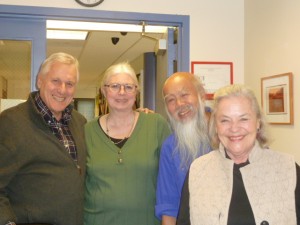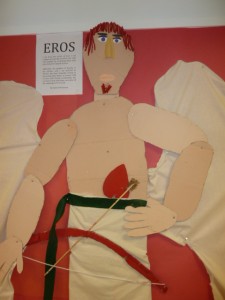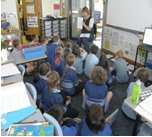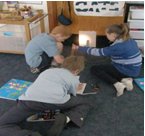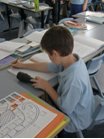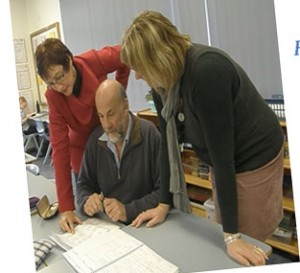We recently posted an article which describes the distance education program between Sa Nguan Ying School in Suphanburi, Thailand, and Lodi High School in Lodi, Wisconsin, USA.
One of the great things about that program is the distance teaching of two teachers from each of the schools and also the contact between students in both schools. It is a way of making US history much more real for Thai students as it is taught by an American teacher, and for their American counterparts, being taught by a Thai teacher from Sa Nguan Ying brings deeper understanding of South East Asian history and culture.
This distance program grew out of the student and teacher exchange program between Lodi and Sa Nguan Ying Schools.
Holly Jean Hargis’ journal posted below is further evidence of the great learning that can come out of an effective student exchange program.
Holly’s journal affirms how this exchange program opened her eyes to the broader world.
Thank you for allowing us to reproduce it here Holly .
Greg Cairnduff
Acting Editor
Letters From Thailand
Holly Jean Hargis
When I first came to Thailand I never would have guessed I would be back a mere 14 months later. I first came as an exchange student from a small town in Wisconsin, and it was my very first time leaving United States. I was 18 years old and a senior in High School, and this would be the longest amount of time that I would spend away from my family.
The Exchange
Travel had always interested me ever since I was young, but I came from a large family who didn’t have the opportunity to do much of this. When my school in Lodi, Wisconsin offered the chance to spend 3 weeks in Thailand , half way across the world, there was no doubt in my mind that I wanted to be part of this experience. I started saving money with a summer job and was able to fund my trip, which was with 9 other students and 3 teachers from my school.
I remember the exact moment I stepped out of the airport into Thailand that first time, I remember feeling the hot and humid air at 3 in the morning and feeling so excited about having the chance to experience another culture. What I didn’t know was that this exact trip would alter the entire course of the following year for me. It would give me courage and opportunity to experience a different life after high school than I ever would have considered before.
My 3 weeks in Thailand went so fast that afterward everything felt like a dream. The exchange program was with Sa-nguan-Ying School in Suphanburi, where I lived with a host family in Thailand and had two sisters with whom I was able to become close with very quickly. My host parents couldn’t speak more than a few words of English but their smiles and laughter everyday made me feel so happy and welcome in this country. I felt a part of the school that I attended every day and also was able to see and learn more about Thailand, so I felt part of Thailand too.
become close with very quickly. My host parents couldn’t speak more than a few words of English but their smiles and laughter everyday made me feel so happy and welcome in this country. I felt a part of the school that I attended every day and also was able to see and learn more about Thailand, so I felt part of Thailand too.
My Decision
It was on the train to Kanchanaburi where I sat with my two best friends agreeing that the 3 amazing weeks in the country could only be the beginning. In this small amount of time we had been introduced to a complete different culture than our own and had made so many new friends. We wondered how much we could learn by travelling more, since we had learned so much about travel, culture, and ourselves in just 3 weeks in Thailand. It was that point when we all talked about taking a year off before college to travel more, and it was at that point I had made the decision I would be travelling abroad very soon again, and maybe even back to Thailand.
Now
Now, 15 months later I sit at a desk in Thailand, at the very same school I visited before. Instead of being a student this time, I was offered the opportunity to be on the other side of the spectrum and work as an assistant teacher, teaching English. I will be here for 8 weeks, and I believe this opportunity to be the best one I have had in my entire life.
In the United States, taking a year off before college is not widely accepted. When I shared with my friends and family that I would be travelling abroad for 8 months prior to enrolling in college, I was welcomed with concern and fear. Now, many months later, these same people are praising me for the opportunities I have been able to experience. Both my parents who have never traveled abroad before visited me on my journey, my Dad visiting me right here in Suphanburi, Thailand. I feel that these opportunities have not only benefited me personally, but those around me as well.
I started my year with the confidence I had gained from the exchange experience in Thailand previously. Starting in October I lived in Paris, France for some time while also travelling to Morocco, London, and Germany. Next, I made my way back to the Land Of Smiles to reunite with many friends and also meet some of the most amazing people I have ever had the chance of calling friends. It would also be the very first time I would live on my own, a huge step for a 19 year old travelling abroad.
Not only did I begin to live on my own, but also began a job, and a job that I loved. I have always wanted to be a teacher and my experience as an assistant teacher here has helped me realize that this is something that I am good at and that I can imagine doing for the rest of my life. I worked with Ms. Tuke, a Thai teacher here who I learned so much from and who I can call a friend. I taught children in grades 7-9 and helped them improve their pronunciation and understanding of the English language. I helped them with their grammar on papers and presentations as well. It feels so good to know that I can help these students learn, and I really feel like they always appreciated my help. The relationships I have made with my students are ones that I value so highly, I absolutely love the students here and I love the tutoring and teaching I have been doing.
This Opportunity
 This teaching opportunity has also given me the wonderful chance of seen more of Thailand. Almost every weekend I was able to travel somewhere new and experience a new part of Thailand. Whether it was seen Wat Poh in Bangkok or spending a weekend with friends at Koh Samet, each experience will be one that I will never forget. Other experiences such as eating Thai dinner every night with friends or learning Thai songs and the Thai language are priceless. All of the friends and teachers I have met here, Thai, American, Chinese, and Tasmanian, have helped me feel so happy in this country and I know the connections I made here will never be lost.
This teaching opportunity has also given me the wonderful chance of seen more of Thailand. Almost every weekend I was able to travel somewhere new and experience a new part of Thailand. Whether it was seen Wat Poh in Bangkok or spending a weekend with friends at Koh Samet, each experience will be one that I will never forget. Other experiences such as eating Thai dinner every night with friends or learning Thai songs and the Thai language are priceless. All of the friends and teachers I have met here, Thai, American, Chinese, and Tasmanian, have helped me feel so happy in this country and I know the connections I made here will never be lost.
I am so thankful that Chaht and the English Program at Sa-nguan-Ying presented me with the opportunity of returning to Thailand. I cannot even express how important the connection is between my school in Lodi and Sa-nguan-Ying. I truly believe and know that I would be a completely different person leading a very different life if I hadn’t been on that trip in November 2010.
The End
It’s now almost 2 months after my second arrival in Thailand and my time is almost up. I cannot believe that I am leaving this wonderful place where I have been given the chance to learn and take away so much. I have learned how to live on my own, I have met wonderful people from over the world, I have built relationships with my students, I have started to learn how to teach, I have learned so much about the Thai culture, I have learned more about myself and I have gained confidence and courage. I feel so lucky to be part of the EP family and I know that I would be welcomed back anytime. As I have learned, most people don’t stay away from Thailand for too long, and I know I’ll be back again in no time.
เราได้ลงบทความที่อธิบายถึงโครงการการศึกษาทางไกลระหว่างโรงเรียนสงวนหญิงในจังหวัดสุพรรณบุรีของประเทศไทยและโรงเรียนโลดี้ในเมืองโลดี้ รัฐวิสคอนซิน สหรัฐอเมริกาไปก่อนหน้านี้
สิ่งที่ยอดเยี่ยมสิ่งหนึ่งของโครงการนี้ก็คือการสอนทางไกลของครูและรวมถึงการติดต่อสื่อสารกันระหว่างนักเรียนของโรงเรียนทั้งสองแห่ง มันเป็นวิธีที่ทำให้การเรียนประวัติศาสตร์อเมริกามีชีวิตชีวามากขึ้นเมื่อได้รับการถ่ายทอดออกจากปากครูชาวอเมริกัน เช่นเดียวกับการเรียนการสอนโดยครูคนไทยจากโรงเรียนสงวนหญิงทำให้นักเรียนอเมริกันเข้าใจประวัติศาสตร์และวัฒนธรรมของเอเชียตะวันออกเฉียงใต้ได้ลึกซึ้งขึ้น
โครงการเรียนทางไกลนี้เกิดขึ้นจากโครงการแลกเปลี่ยนครูและนักเรียนระหว่างโรงเรียนโลดี้และโรงเรียนสงวนหญิง
บทความของฮอลี่ จีน แฮกริดด้านล่างคือประจักษ์พยานในอนาคตของการเรียนรู้ที่ยิ่งใหญ่ที่สามารถได้มาจากโครงการนักเรียนแลกเปลี่ยนที่มีประสิทธิภาพ
บทความของฮอลี่อธิบายวิธีที่โครงการแลกเปลี่ยนนี้เปิดมุมมองของเธอสู่โลกที่กว้างขึ้น
ขอขอบคุณสำหรับความเอื้อเฟื้อที่ให้เรานำข้อความของเธอมาลงในที่นี้
เกรก แคนดัฟฟ์
รักษาการณ์บรรณาธิการ
________________________________________
จดหมายจากเมืองไทย
ฮอลี่ จีน แฮกริด
ครั้งแรกที่ฉันมาไทย ฉันไม่เคยนึกเลยว่าฉันจะได้กลับมาอีกครั้งในอีก 14 เดือนให้หลัง ฉันมาที่นี่ครั้งแรกในฐานะนักเรียนแลกเปลี่ยนจากเมืองเล็กๆในวิสคอนซิน และนั่นเป็นครั้งแรกที่ฉันออกนอกสหรัฐอเมริกา ตอนนั้นฉันอายุ 18 ปี เป็นนักเรียนมัธยมปลาย และนี่คือการใช้ชีวิตห่างจากบ้านและครอบครัวครั้งที่นานที่สุดของฉัน
โครงการแลกเปลี่ยน
การท่องเที่ยวเป็นเรื่องที่ฉันสนในมาตั้งแต่เด็ก แต่ฉันอยู่ในครอบครัวใหญ่ที่ไม่มีโอกาสทำอย่างนั้นได้มากนัก เมื่อที่โรงเรียนโลดี้ที่ฉันเรียนยื่นโอกาสที่จะได้ใช้ชีวิต 3 สัปดาห์ในเมืองไทย ประเทศที่ห่างไกลไปอีกซีกโลก ฉันไม่ลังเลเลยที่จะเข้าเป็นส่วนหนึ่งของประสบการณ์ในครั้งนี้ ฉันเริ่ม

เก็บเงินจากงานพิเศษในช่วงหน้าร้อนจนมีทุนพอสำหรับการเดินทาง ร่วมกับเพื่อนนักเรียน 9 คนและครูอีก 3 ท่าน
ฉันจำได้ชัดเจนถึงครั้งแรกที่ก้าวออกจากสนามบินที่เมืองไทย จำได้ถึงความร้อนชื้นของอากาศตอนตี 3 และตื่นเต้นมากที่จะมีโอกาสได้สัมผัสกับวัฒนธรรมที่แตกต่าง ที่ฉันไม่รู้ก็คือ การเดินทางครั้งนี้เป็นตัวสำคัญที่จะเปลี่ยนวิชาเรียนในปีที่เหลือของฉันไปทั้งหมด มันให้ความกล้าและโอกาสแก่ฉันที่จะได้รับประสบการณ์ชีวิตหลังเรียนจบในแบบที่ฉันไม่เคยนึกถึงมาก่อน
3 สัปดาห์ในเมืองไทยผ่านไปอย่างรวดเร็วจนราวกับความฝันเมื่อมองย้อนกลับไป โครงการแลกเปลี่ยนมีขึ้นที่โรงเรียนสงวนหญิงในจังหวัดสุพรรณบุรี ฉันอาศัยอยู่กับครอบครัวอุปถัมภ์และน้องสาว 2 คนที่เราสนิทกันได้อย่างรวดเร็ว พ่อแม่อุปถัมภ์ของฉันไม่รู้ภาษาอังกฤษมากนักนอกจากคำง่ายๆไม่กี่คำ แต่รอยยิ้มและเสียงหัวเราะของพวกเขาในทุกๆวันทำให้ฉันมีความสุขและรู้สึกว่าตัวเองเป็นที่ต้อนรับจากประเทศนี้ ฉันรู้สึกเป็นส่วนหนึ่งของโรงเรียนที่ซึ่งฉันไปทุกวันและได้เห็นและเรียนรู้เพิ่มขึ้นเกี่ยวกับประเทศไทย ฉันจึงรู้สึกเป็นส่วนหนึ่งของประเทศไทยด้วยเช่นกัน
การตัดสินใจของฉัน
บนรถไฟที่มุ่งหน้าไปกาญจนบุรี ฉันกับเพื่อนสนิท 2 คนเห็นพ้องกันว่า 3สัปดาห์ที่แสนมหัศจรรย์ในประเทศนี้นั้นเป็นเพียงแค่การเริ่มต้น ในช่วงระยะเวลาสั้นๆพวกเราได้รู้จักกับวัฒนธรรมที่แตกต่างอย่างสิ้นเชิงกับของเราเองและได้สร้างเพื่อนใหม่เพิ่มขึ้นมากมาย เราเฝ้าสงสัยว่าเราจะเรียนรู้ได้มากแค่ไหนถ้าเราเดินทางมากกว่านี้หลังจากที่เราได้เรียนรู้มามากเกี่ยวกับการท่องเที่ยว, วัฒนธรรม และตัวของเราเองในเวลาเพียงแค่ 3 สัปดาห์ในประเทศไทย และนั้นคือจุดที่ฉันตัดสินใจว่าฉันจะออกเดินทางอีกครั้งในเร็วๆนี้ และบางทีอาจจะกลับมาที่นี่อีก
ปัจจุบัน
15 เดือนต่อมา ตอนนี้ฉันนั่งอยู่ที่โต๊ะของตัวเอง ในโรงเรียนเดิมที่ฉันเคยมาที่ประเทศไทย แต่แทนที่จะเป็นในฐานะนักเรียน ฉันได้รับการให้โอกาสที่จะมาเป็นคนที่ยืนอยู่ในอีกด้านหนึ่งและทำงานเป็นผู้ช่วยอาจารย์/อาจารย์ฝึกสอน ในวิชาภาษาอังกฤษ ฉันจะอยู่ทีนี่ 8 สัปดาห์และฉันมั่นใจว่านี่จะเป็นโอกาสที่ดีที่สุดที่ฉันเคยได้รับมาในชีวิต
ในสหรัฐอเมริกา การหยุดไปหนึ่งปีก่อนจะเข้าเรียนระดับอุดมศึกษาไม่ได้เป็นที่ยอมรับกันในวงกว้าง เมื่อฉันบอกกับเพื่อนและที่บ้านว่าฉันจะเดินทางท่องเที่ยวเป็นเวลา 8เดือนก่อนจะเข้าวิทยาลัย ปฏิกิริยาที่ได้รับคือความกังวลและกลัว ตอนนี้ หลายเดือนต่อมา พวกเขาต่างยินดีกับฉันสำหรับประสบการณ์ที่ฉันมีโอกาสได้สัมผัส พ่อและแม่ของฉันผู้ซึ่งไม่เคยเดินทางออกนอกประเทศมาก่อนได้มาเยี่ยมฉันตอนที่ฉันยังเดินทางอยู่ การที่พ่อมาหาฉันถึงประเทศไทยที่จังหวัดสุพรรณบุรี ฉันรู้สึกว่าโอกาสที่ฉันได้นี้ไม่เพียงมีประโยชน์ต่อตัวเอง แต่รวมไปถึงคนรอบข้างฉันด้วยเช่นกัน
ฉันเริ่มต้นการเดินทางด้วยความมั่นใจที่เคยได้รับจากประสบการณ์แลกเปลี่ยนในประเทศไทยที่มาก่อนหน้านี้ เริ่มต้นในเดือนตุลาคมฉันอาศัยอยู่ที่ปารีส ประเทศฝรั่งเศสอยู่ระยะหนึ่งและยังไปโมรอคโค ลอนดอน และเยอรมัน ต่อมา ฉันมุ่งหน้ากลับมายังดินแดนแห่งรอยยิ้มเพื่อพบกับเพื่อนหลายคนและคนที่น่าทึ่งมากมายที่ฉัยเคยมีโอกาสเรียกพวกพวกว่าเพื่อน และมันยังเป็นครั้งแรกที่ฉันจะใช้ชีวิตอยู่ด้วยตัวเอง เป็นก้าวที่ใหญ่มากสำหรับเด็กอายุ 19 คนหนึ่ง
ไม่เพียงเริ่มต้นใช้ชีวิตอยู่ตัวคนเดียว แต่เริ่มต้นทำงาน ซึ่งเป็นงานที่ฉันรักด้วย ฉันใฝ่ฝันอยากจะเป็นครูมาโดยตลอก และประสบการณ์ของการเป็นครูฝึกสอนที่นี่ทำให้ฉันตระหนักว่ามันเป็นสิ่งที่ฉันสามารถทำได้ดีและฉันสามารถนึกภาพตัวเองทำมันไปจนตลอดชีวิตได้ ฉันทำงานกับครูตุ๊ก ครูคนไทยที่ฉันสามารถเรียกว่าเพื่อนและได้เรียนรู้มากมายจากเธอ ฉันสอนนักเรียนชั้นม.1ถึงม.3 ฉันช่วยเด็กๆให้พัฒนาทักษะการสอนเสียงและความเข้าใจในภาษาอังกฤษ รวมถึงหลักไวยากรณ์ในแบบฝึกหัดและการนำเสนอต่างๆเช่นกัน มันรู้สึกดีมากที่ได้รู้ว่าฉันสามารถช่วยเหลือเด็กๆในการเรียนได้ และฉันรู้สึกจริงๆว่าพวกเขาตื้นตันกับความช่วยเหลือของฉันเสมอ ความสัมพันธ์ที่ฉันมีต่อนักเรียนเป็นสิ่งหนึ่งที่ฉันให้ความสำคัญกับมันสูงมาก ฉันรักพวกนักเรียนมากและฉันรักการสอนที่ฉันทำอยู่
โอกาสในครั้งนี้

การที่ฉันมีโอกาสสอนที่นี่ทำให้ฉันมีโอกาสได้เห็นประเทศไทยมากขึ้น เกือบทุกอาทิตย์ฉันจะเดินทางไปโน่นมานี่เพื่อสัมผัสประสบการณ์ใหม่ๆในเมืองไทย ไม่ว่าจะเป็นการไปดูวัดโพธิ์ในกรุงเทพมหานครหรือไปเที่ยวเกาะเสม็ดกับเพื่อน ทั้งหมดนี้เป็นประสบการณ์ที่ฉันจะไม่มีวันลืม การกินอาหารไทยตอนเย็นกับเพื่อนหรือการเรียนเพลงไทยและภาษาไทยเป็นประสบการณ์ที่ประเมินค่าไม่ได้ เพื่อนและครูทุกคนที่ฉันได้พบ ทั้งคนไทย,คนอเมริกัน, คนจีนและคนแทสมาเนียน ช่วยให้ฉันรู้สึกมีความสุขและฉันรู้ว่าสายสัมพันธ์ที่เราสร้างขึ้นนั้นจะไม่มีวันจางหาย
ฉันรู้สึกขอบคุณที่แชตและโครงการภาษาอังกฤษที่โรงเรียนสงวนหญิงเสนอให้ฉันมีโอกาสได้กลับมายังประเทศไทย ฉันไม่อาจจะอธิบายความสำคัญของการเชื่อมโยงระหว่างโรงเรียนของฉันที่โลดี้และโรงเรียนสงวนหญิง ฉันมั่นใจว่าฉันจะกลายเป็นคนละคนและดำเนินชีวิตแตกต่างจากนี้อย่างสิ้นเชิงถ้าไม่ฉันไม่ได้มาที่นี่เมื่อเดือนพฤศจิกายน 2553
สุดท้ายนี้
เป็นเวลาเกือบ 2 เดือนหลังจากการมาเมืองไทยครั้งที่ 2 ของฉันและตอนนี้เวลาของฉันก็เกือบหมดแล้ว ไม่อยากเชื่อว่าฉันกำลังจะบอกลาที่ที่ฉันเคยได้รับโอกาสในการเรียนรู้และได้รับสิ่งต่างๆกลับไปมากมาย ฉันเรียนรู้ที่จะอยู่ด้วยตัวเอง ได้พบผู้คนที่น่าทึ่งจากทั่วโลก สร้างความสัมพันธ์กับนักเรียน เริ่มต้นเรียนรู้วิธีการสอน ฉันได้เรียนรู้เรื่องต่างๆเกี่ยวกับวัฒนธรรมไทย ได้รู้จักตัวเองมากขึ้นและมีความมั่นใจมากขึ้น ฉํนรู้สึกว่าตัวเองโชคดีมากที่ได้เป็นส่วนหนึ่งของครอบครัวอุปถัมภ์ที่เมืองไทยและฉันรู้ว่าที่นี่จะยินดีต้อนรับฉันทุกเมื่อ เท่าที่ฉันเคยทราบ คนส่วนใหม่จะไม่อยู่ห่างประเทศไทยเป็นเวลานานๆ และฉันรู้ว่าฉันจะกลับมาที่นี่อีกครั้งในไม่นาน


